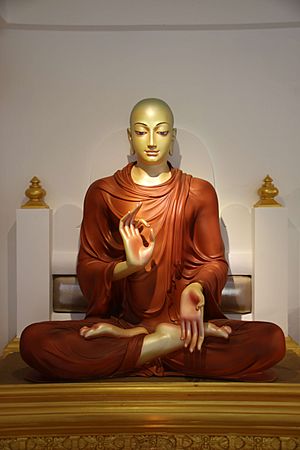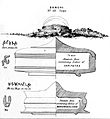Śāriputra facts for kids
Quick facts for kids Śāriputra |
|
|---|---|

Statue of Śāriputra, depicting his "golden complexion".
|
|
| Religion | Buddhism |
| School | all |
| Dharma names | Śāriputra |
| Personal | |
| Born | Upatiṣya (Pali: Upatissa) Nālaka or Upatiṣya Village, Rajgir, Magadha |
| Died | Nālaka or Upatiṣya Village, Rajgir, Magadha |
| Parents | Vaṇganta or Tisya (father), Sāri (mother) |
| Senior posting | |
| Title | First chief disciple (Paṭhamasāvaka), right hand side chief disciple (Dakkhinasāvaka), foremost of the wise |
| Religious career | |
| Teacher | Gautama Buddha |
| Translations of Śāriputra |
|
|---|---|
| Sanskrit | शारिपुत्र Śāriputra |
| Pali | Sāriputta |
| Burmese | ရှင်သာရိပုတ္တရာ (Shin Sāriputtarā) (IPA: [ʃɪ̀ɴθàɹḭpoʊʔtəɹà]) |
| Chinese | 舎利弗 (Pinyin: Shèlìfú) 舎利子 (Pinyin: Shèlìzi) |
| Japanese | (rōmaji: Sharihotsu) (romaji: Sharishi) |
| Khmer | សារីបុត្រ (UNGEGN: sareibŏt) |
| Korean | 사리불 (RR: Saribul) 사리자 (RR: Sarija) |
| Sinhala | සාරිපුත්ත |
| Tibetan | ཤཱ་རིའི་བུ་ (Wylie: shA ri'i bu) (THL: sha ri bu) |
| Thai | สารีบุตร (RTGS: Saribut) |
| Vietnamese | Xá Lợi Phất Xá Lợi Tử |
| Glossary of Buddhism | |
|
Basic terms |
|
|
People |
|
|
Schools |
|
|
Practices |
|
|
study Dharma |
|
Śāriputra (pronounced Shar-ee-POO-tra) was one of the most important students of the Buddha. He was known for his great wisdom. His original name was Upatiṣya, but he became known as Śāriputra, which means "the son of Śāri" (his mother's name).
Śāriputra was considered the first of the Buddha's two main male students. The other main student was Maudgalyāyana. Śāriputra played a very important role in helping the Buddha teach others. He is also thought to have helped develop the Buddhist Abhidharma, which is a detailed study of Buddhist teachings.
Contents
Early Life and Becoming a Disciple
Śāriputra and Maudgalyāyana were friends since they were children. They both grew up in a place called Nālaka or Upatiṣya Village, near Rajgir, in ancient India. As young men, they left their homes to search for spiritual truth. They studied with different teachers, but they were not fully satisfied with what they learned.
Meeting the Buddha
One day, Śāriputra met a Buddhist monk named Assaji. Assaji told him about the Buddha's teachings. Śāriputra was very impressed and immediately went to tell Maudgalyāyana. Together, they went to meet the Buddha.
Joining the Sangha
After hearing the Buddha's teachings, both Śāriputra and Maudgalyāyana decided to become monks. They joined the Buddha's community of monks, called the Sangha. The Buddha soon declared them his two chief disciples. Śāriputra became enlightened, meaning he reached a deep understanding of truth, just two weeks after becoming a monk.
Śāriputra's Role and Wisdom
As a chief disciple, Śāriputra took on many important jobs in the Sangha. He helped look after other monks and taught them how to meditate. He also explained difficult parts of the Buddha's teachings. He was the first student the Buddha allowed to ordain, or formally accept, new monks into the community.
General of the Dharma
Śāriputra was famous for following the Buddhist monastic rules very strictly. He was also known for his incredible wisdom and his ability to teach clearly. Because of his skills, he was given the special title "General of the Dharma." The Dharma refers to the Buddha's teachings. This title showed how important he was in spreading and protecting the Buddhist path.
Foremost in Wisdom
Śāriputra is especially remembered as the Buddha's student who was best at understanding and sharing wisdom. In Buddhist art, he is often shown standing next to the Buddha, usually on the Buddha's right side. This shows his high status and importance.
Later Life and Legacy
Śāriputra passed away shortly before the Buddha did. He died in his hometown. After his death, his body was cremated, which means it was burned. His ashes, called relics, were then placed in a special shrine at Jetavana Monastery.
Relics and Stupas
Later, some kings may have moved or shared his relics across India. In the 1800s, archaeologists found some relics that are believed to be Śāriputra's in ancient structures called stupas at a place called Sanchi. These findings help us learn more about the history of Buddhism.
Śāriputra is still seen as a very important and wise disciple of the Buddha, especially in Theravada Buddhism. His teachings and example continue to inspire many people today.
Images for kids
-
One of the Sanchi stupas, where relics of Śāriputra were excavated.
See also
 In Spanish: Shariputra para niños
In Spanish: Shariputra para niños









